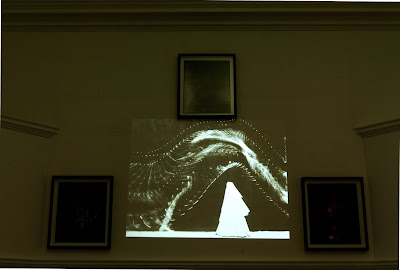James Sey's installation Sublimation and Reversibility
Artist's statement
This installation responds to the brief for Time’s Arrow by focusing on three epheremal pieces; not, strictly speaking, even works in the JAG collection. The works are three X-rays of paintings in the collection, as follows:
This installation responds to the brief for Time’s Arrow by focusing on three epheremal pieces; not, strictly speaking, even works in the JAG collection. The works are three X-rays of paintings in the collection, as follows:
- Regina Cordium (1860), D.G.Rossetti
- Girl with a Pitcher/The Huntsman (c.18thC) attributed to Dominicus van Tol
- Lake Garda (1927) Maggie Laubser.
The first medical X-ray photograph was taken in 1895 by Wilhelm Röntgen. This was a time when such technological devices to measure and record previously unrecordable and little understood physical processes were proliferating. These technologies focused, with the notable exception of the work of E.J. Marey, on visualisation, culminating in the dominance of cinema technologies in 20th century culture. The use of X-rays in art has been largely limited to revealing layers of paint and other materials underneath the ostensible work, in order to aid the process of the restoration of paintings in gallery collections.
Two of the X-rays selected for this installation are unusual in that they reveal different images underneath the one apparent as the work in the JAG collection – the paintings attributed to van Tol obscure a two-panel image of a Virgin and Child, whose provenance and authorship is uncertain; and the painting of Lake Garda by Laubser obscures a self-portrait by the artist. The Rossetti, on the other hand, reveals in X-ray the brushwork and layers of pigmentation which make up the ‘mechanical’ constituents of the finished painting.
What brings all three together is that they are, in different ways, technological palimpsests of women – the Virgin, the artist, and, in the subject of Rossetti’s painting, the idealised lover. The ability of the technology to reveal thus also raises the spectre of obfuscation – of the aesthetic meaning of the work. The X-ray also thus reveals a temporal dimension to the works which perforce becomes part of their meaning. However, this temporality is not sequential – does not move inevitably forward. Is what we see when we look at the works the primary image, or can the obscured image recaptured by the machine come to replace the ‘finished’ work in terms of time, space and meaning?
Another dimension to these works is that of the position of women in them. A Romantic idealisation of women characterises the Pre-Raphaelite Brotherhood, and Rossetti’s painting is typical in this regard – women become, in this ideal framing, figures of the sublime, transcendental embodiments of the beautiful. The relationship, and the etymological affinity, between the theory of the sublime and the psychological process of sublimation – the channelling of libidinal energy into higher, aesthetic, pursuits – is obvious. What these X-rayed women; the Virgin and the erased artist, and their Romanticised Pre-Raphaelite counterpart (reduced in X-ray to her constituent brushmarks and pigments) reveal is another aesthetic dimension to sublimity and sublimation. This time, it is conditioned by a visual technology that, in its palimpsestuous character and propensity to manipulate the sequential nature of time, problematises the link between vision and aesthetic meaning itself.
In the installation, these ephemeral pieces of technological detritus are restored to the state of ‘finished’ digital prints, excavated from their status as a buried and archived trace of other works into the object within the frame themselves. Two of them have been retouched to emphasise this process. They frame, in turn, a short film which partly dramatises the situation of these women, and child, in an official city gallery in a city, Johannesburg, which is itself notable for its palimpsestuous character. Reversibility – a key component of film technology – serves as a technological means to investigate the aesthetic dimensions of the relationship between sublimation, the palimpsest and temporal flow, and this forms the core theme of the film.
© James Sey 2010.

